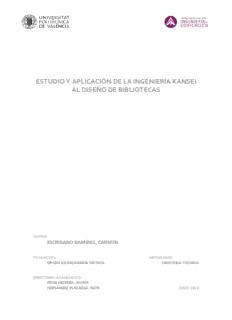Table Of ContentESTUDIO Y APLICACIÓN DE LA INGENIERÍA KANSEI
AL DISEÑO DE BIBLIOTECAS
AUTOR:
ESCRIBANO RAMÍREZ, CARMEN
TITULACIÓN: MODALIDAD:
GRADO EN INGENIERÍA TÉCNICA CIENTÍFICO-TÉCNICO
DIRECTORES ACADÉMICOS:
PONS MORERA, MARÍA
FERNÁNDEZ PLAZAOLA, IGOR JULIO 2013
AGRADECIMIENTOS
A mi familia, por apoyarme en todo
momento y confiar en mí, todo esto
es gracias a vosotros.
A mis amigos, compañeros de
noches en vela, sin ellos esto no
habría sido lo mismo. Siempre
dispuestos a ayudar en lo que fuera
necesario, a Roberto y Borja. Gracias
a todos por estar ahí.
RESUMEN
El diseño de un producto o un espacio arquitectónico debe hacerse siempre con la finalidad de
satisfacer todas las necesidades que el consumidor de este producto espera.
Si hablamos de Bibliotecas Universitarias, estas deben de reunir una serie de condiciones para
que el tiempo durante el cual un usuario permanezca en ella sea lo más agradable posible.
La Ingeniería Kansei nos ofrece unos métodos de estudio y análisis gracias a los cuáles
podemos determinar cuáles son esas condiciones y requisitos, para poder aplicarlos al
proyecto de una biblioteca, y crear así un espacio que provoque unas emociones y sensaciones
positivas en el usuario.
Este proyecto trata sobre la aplicación de este método, la Ingeniería Kansei, al diseño de una
Biblioteca Universitaria.
SUMMARY
The design of a product or architectural space must be provided in order to meet all consumer
needs that the expected product.
If we speak of University Libraries, they must meet a number of conditions for the time during
which a user remains in it as enjoyable as possible.
Kansei Engineering offers a study and analysis methods thanks to which we can determine
what those conditions and requirements could be applied to a library project, and create a
space that causes emotions and positive feelings about the user.
This project deals with the application of this method, Kansei Engineering, the design of a
University Library.
RESUM
El disseny d'un producte o un espai arquitectònic deu realitzar-se sempre amb la finalitat de
abastir totes les necessitats que el consumidor d'aquest producte espera.
Si parlem de Biblioteques Universitàries, aquestes deuen de reunir una serie de condicions per
a que el temps durant el qual un usuari estiga en ella siga el mes agradable possible.
L'enginyeria Kansei ens ofereix uns mètodes d'estudi i anàlisis gracies als quals podem
determinar quines son eixes condicions i requisits, per a poder aplicar-los al projecte d'una
biblioteca, i crear així un espai que provoque unes emocions i sensacions positives en l'usuari.
Aquest projecte tracta sobre l'aplicació d'aquest mètode, l'enginyeria Kansei, al disseny d'una
Biblioteca Universitaria.
ESTUDIO Y APLICACIÓN DE LA INGENIERÍA KANSEI
AL DISEÑO DE BIBLIOTECAS
ÍNDICE
CAPÍTULO 1. INTRODUCCIÓN 1
1.1 ANTECEDENTES 3
1.2 ESTRUCTURA DEL TRABAJO 6
CAPÍTULO 2. REVISIÓN BIBLIOGRÁFICA 9
2.1 TÉCNICAS DE DISEÑO DE PRODUCTOS ORIENTADOS AL USUSARIO 11
2.1.1 DISEÑO ORIENTADO AL USUARIO 11
2.1.2 ¿QUÉ ES KANSEI? 12
2.1.3 HISTORIA INGENIERÍA KANSEI 14
2.1.4 TIPOS DE KANSEI 15
2.1.5 FASES DE LA INGENIERÍA KANSEI 18
2.1.6 APLICACIONES DE LA INGENIERÍA KANSEI 21
2.2 OBJETO DE ESTUDIO: LA BIBLIOTECA 25
2.2.1 HISTORIA DE LA BIBLIOTECA 26
2.2.2 ESTUDIO DEL ESPACIO ARQUITECTÓNICO: LA BIBLIOTECA UNIVERSITARIA 28
2.2.3 ELEMENTOS DEL MOBILIARIO EN UNA BIBLIOTECA 30
2.2.4 ARTICULACIÓN DE ESPACIOS DENTRO DE LA BIBLIOTECA UNIVERSITARIA 36
2.2.5 OBJETIVOS DE LA BUENA BIBLIOTECA 38
CAPÍTULO 3. OBJETIVOS 41
CAPÍTULO 4. MATERIAL Y MÉTODOS 45
ESTUDIO Y APLICACIÓN DE LA INGENIERÍA KANSEI
AL DISEÑO DE BIBLIOTECAS
CAPÍTULO 5. RESULTADOS 57
5.1 RESULTADOS ENCUESTAS BIBLIOTECAS Y ENCUESTAS CAMPUS. DATOS 59
5.1.1 DATOS BIBLIOTECAS 59
5.1.2 DATOS CAMPUS 62
5.1.3 DATOS EXPERTOS 63
5.1.4 MEDIAS DATOS 64
5.2 RESULTADOS ENCUESTA EDR 67
5.2.1 ANÁLISIS DE FRECUENCIA 67
5.2.1.1 GENERAL 67
5.2.1.2 GÉNERO 68
5.2.1.3 EDAD 69
5.2.1.4 RELACIÓN CON LA UPV 71
5.2.1.5 CURSO 72
5.2.1.6 CÓMO ACUDE A LA BIBLIOTECA 74
5.2.1.7 FRECUENCIA 75
5.2.1.8 UBICACIÓN 76
5.2.1.9 MOTIVO 77
5.2.1.10 TIEMPO DE PERMANENCIA 79
5.2.2 CORRELACIONES BIVARIADAS 80
5.2.2.1. CORRELACIÓN “VALORACIÓN BUEN DISEÑO” CON LOS “EJES SEMÁNTICOS” 80
5.2.2.2 CORRELACIÓN “EJE SEMÁNTICO 8, ORGANIZACIÓN Y EFICIENCIA” CON LOS
“GRUPOS DE ELEMENTOS DE DISEÑO” 81
ESTUDIO Y APLICACIÓN DE LA INGENIERÍA KANSEI
AL DISEÑO DE BIBLIOTECAS
5.2.2.3. CORRELACIÓN “EJE SEMÁNTICO 9, VERSÁTIL Y POLIVALENTE” CON LOS
“GRUPOS DE ELEMENTOS DE DISEÑO” 82
5.2.2.4. CORRELACIÓN “EJE SEMÁNTICO 10, AMPLITUD DE HORARIOS” CON LOS
“GRUPOS DE ELEMENTOS DE DISEÑO” 83
5.2.2.5. CORRELACIÓN “EJE SEMÁNTICO 14, PERMITE RELACIONARSE” CON LOS
“GRUPOS DE ELEMENTOS DE DISEÑO” 84
5.2.2.6. CORRELACIÓN “EJE SEMÁNTICO 15, ALEGRE Y JUVENIL” CON LOS “GRUPOS DE
ELEMENTOS DE DISEÑO” 85
5.2.2.7. CORRELACIÓN “VALORACIÓN GLOBAL BUENA BIBLIOTECA” CON LOS “EJES
SEMÁNTICOS” 86
CAPÍTULO 6. CONCLUSIONES 87
BIBLIOGRAFÍA 93
ANEXOS 99
ANEXO 1. CRITERIOS PASE ENCUESTAS BIBLIOTECA 101
ANEXO 2. ENCUESTA BIBLIOTECA 105
ANEXO 3. CRITERIOS PASE ENCUESTAS CAMPUS 109
ANEXO 4. ENCUESTA CAMPUS 113
ANEXO 5. CRITERIOS PASE ENCUESTAS EDR 117
ANEXO 6. ENCUESTA EDR 121
Description:La Ingeniería Kansei nos ofrece unos métodos de estudio y análisis gracias a
En el Food Kansei Model los atributos intrínsecos son los relacionados con
la

